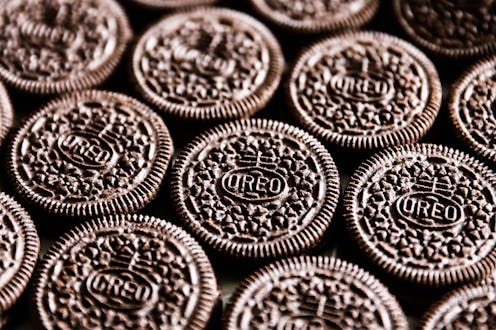Life
There's A Trick To Twisting Oreos

Iconic and delicious, the Oreo has provided many endless hours of edible entertainment and helped settle family discrepancies the world over through the famous Oreo twist. The excitement that arises from trying to predict which side of the Oreo gets the icing when twisted is quite frankly, unparalleled — what other cookie is famed for providing quite so much joy before you even eat it? And if you've ever indulged in the highly addictive practice of twisting, pre Oreo-ingestion, (of course you have) you'll know what I mean.
But now, in ground-breaking news that concerns anyone who's ever let one of these sweet, round cookies grace their lips, the mystery of the Oreo twist has finally been solved — by aerospace engineers. Dan Quinn, Joshua Spechler and John Cannarella, were all studying together at Princeton’s mechanical and aerospace engineering program in 2014, when they decided to investigate whether or not they could predict, with accuracy, the Oreo twist outcome. Explaining his interest in the phenomena, Quinn (who is now a postdoc at Stanford University) told Quartz, “The Oreo was our generation’s wishbone" — which is so poetically beautiful, I feel like it should be the cookies next ad campaign.
After Cannarella said he had a childhood friend who somehow always won the Oreo twist game, they set about searching online for an answer, but found that no-one had yet concerned themselves with how to predict the outcome of the Oreo twist. This almost made them stop their research there and then.
Happily, though, the team persevered. They started by analyzing the mechanics of the Oreo before subjecting it to rigorous experiments at — where else? — college parties. “We threw the books at it,” Spechler said to Quartz. “We’d break the cookies out at parties and tell people they needed to be live subjects.” When this didn't yield conclusive results, they moved onto more scientific testings, putting thousands of cookies into a support structure designed to repeatedly test forces on objects to pull the cookies apart. They also used a rotation rig to test the twisting method. Nothing worked.
Eventually the Princeton grads realized what had been staring them in the face the whole time: The cream came out on the same side, on every cookie, in every box, each and every time. How? Well it's actually a side effect of the manufacturing process. Try it: All you need to do is place the package of cookies in front of you so that its text faces the right way; then, when you take a cookie out of the package, make sure you grab it from the upper left hand corner. Twist it: If the icing ends up on the left cookie, then that's the way it'll be for every cookie in the box. The same goes for if the icing ends up on the right cookie. Apparently it's all down to the way in which the icing flows, when hot, onto the first wafer; the second wafer always gets less as a result.
Cookie science, by the way, isn't limited simply to Oreos; other researchers have also determined, for example, why we prefer cookies when they've been dunked in something (milk, tea, coffee — take your pick), as opposed to plain. According to cookbook author Heston Blumenthal, who performed a wide array of tests with a machine meant to "measure the amount of flavor released in your mouth as aromas when you take a sip of Cabernet, melt a chocolate bar on your tongue, or chew on a cookie" — and apparently cookies release more flavor and aroma when they're dunked. Apparently the compound Methylbutanol, which gives baked goods their "toasty" flavor, according to The Kitchn, is released more easily when your cookie is damp. Hence, dunked cookies being superior to plain cookies.
Who knew cookies had so much to them?
Images: NurPhoto/NurPhoto/Getty Images; Giphy (3)